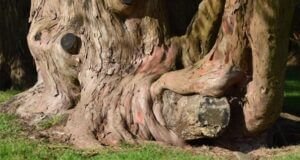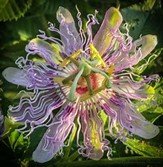help with insomnia
Bonne Nuit Tea
Bonne Nuit Tea
Bonne Nuit Tea is formulated to help with insomnia, to induce sedation, neuroprotection, calmness and relaxation, without depressing. High in neolignands; (magnolol and honokiol) which work via cannabinoid receptors, to reduce brain inflammation, anxiety and oxidative stress. This infusion contains volatile oils to help ease muscle tensions, spasms (especially of the viscera) and irritability. Deep restful sleep is required for healthy immune function and brain restoration.
To balance circadian rhythms, and hormonal, melatonin production, using natures toolbox, it is advised to watch the sun rise each morning, and the moon at night. Keep artificial light at a minimum. Exercise, outside in natural sunlight, on the earth, with no shoes.
Directions: One teaspoon to one cup of boiling water. Steep for 10 minutes. Honey may be added. 1 cup with dinner and 1 cup before bed for acute conditions.
Ingredients: 50 gms
Hou po/Magnolia officinalis
Magnolia bark
 The bark of the Magnolia tree is highly prized in Chinese medicine, known as Hou po. Magnolia grows at high altitudes. It is known for its relaxing properties, to treat anxiety and also as a calming sedative, which helps with insomnia. However, Magnolia is also highly neuroprotective. The bark is extremely rich in polyphenol anti-oxidants, neolignans: (magnolol and honokiol). These neolignans have been researched extensively to reduce inflammation and oxidative stress to the brain and spinal cord. Magnolia bark has been cited as having benefit for brain conditions such as Alzheimer’s, stress, anxiety, depression. The bioactive compounds, neolignans: (magnolol and honokiol), activate cannabinoid receptors. These receptors, located throughout the body, are part of the endocannabinoid system, and researched extensively by scientists for its role in immune health, and pain relief. Activation of these receptors helps to relieve pain, reduce inflammation, and elevate mood, among many other benefits. Research in mice shows magnolia bark’s bioactive compounds can help maintain levels of acetylcholine, a neurotransmitter that helps the brain process memory and learning, as well as boosting GABBA production. Other research shows that these compounds also balance cortisol levels, can be used for cancer therapy, weight loss and diabetes.
The bark of the Magnolia tree is highly prized in Chinese medicine, known as Hou po. Magnolia grows at high altitudes. It is known for its relaxing properties, to treat anxiety and also as a calming sedative, which helps with insomnia. However, Magnolia is also highly neuroprotective. The bark is extremely rich in polyphenol anti-oxidants, neolignans: (magnolol and honokiol). These neolignans have been researched extensively to reduce inflammation and oxidative stress to the brain and spinal cord. Magnolia bark has been cited as having benefit for brain conditions such as Alzheimer’s, stress, anxiety, depression. The bioactive compounds, neolignans: (magnolol and honokiol), activate cannabinoid receptors. These receptors, located throughout the body, are part of the endocannabinoid system, and researched extensively by scientists for its role in immune health, and pain relief. Activation of these receptors helps to relieve pain, reduce inflammation, and elevate mood, among many other benefits. Research in mice shows magnolia bark’s bioactive compounds can help maintain levels of acetylcholine, a neurotransmitter that helps the brain process memory and learning, as well as boosting GABBA production. Other research shows that these compounds also balance cortisol levels, can be used for cancer therapy, weight loss and diabetes.
Actions: Activator of cannabinoid receptors. GABBA booster, An adrenaline inhibitor. Neuroprotective, Sedative, Anti-inflammatory, Anti-oxidant to the brain and spinal cord. Cortisol balancing. Anti- depressive.
Lavandula angustiflolia
Lavender flowers

Cited by John Parkinson Herbalist in 1640 “especially good use for all griefs and pains of the head and brain”.
Actions: Anxiolytic, Sedative, Nerve tonic, Neuroprotective, Anti-Depressant, Anti-spasmodic to muscles, Antioxidant, Antiseptic
Chamomilla recuitita
Chamomile flowers

Actions: Relaxant, anti-inflammatory, carminative, antispasmodic, anti-allergenic.
Passiflora incarnata
Passionflower ariel parts


The flower has been thought to represent Christs crucifixion, 5 stamens for the 5 wounds, 3 styles for the 3 nails and the white and blue flowers for purity and heaven.
Actions: Tranquilising, Antispasmodic, Sedative, Peripheral vasodilator.
Actions: Anxiolytic, Sedative, Nerve tonic, Neuroprotective, Anti-Depressant, Anti-spasmodic to muscles, Antioxidant, Antiseptic
References: A Clinical Guide to Blending Liquid Herbs: Herbal Formulations for the Individual Patient” 2003 Kerry Bone Elservier Science (USA)
A Modern Herbal; 1994 Mrs M. Grieve F.R.H.S. First published in 1931 by Johnathan Cape Ltd. Great Britain. A Cresset Press Book
E/S/C/O/P Monographs Second Edition supplement 2009
The Encyclopedia of Medicinal Plants, 2001 Andrew Chevallier, Dorling Kindersley
Pty Ltd
https://www.healthline.com/nutrition/magnolia-bark https://www.psychologytoday.com/au/blog/sleep-newzzz/201809/is-magnolia-bark-the-missing-link-your-sleep-and-health
https://www.ncbi.nlm.nih.gov/pmc/articles/PMC3612440/ Lavender and the nervous system
Warning; These herbal infusions are a superfood in the rawest form. They are not to replace prescription medication from a medical professional. Please seek medical advice for any ongoing health conditions. If allergies occur, discontinue use.
Cost $18 plus $10 postage


